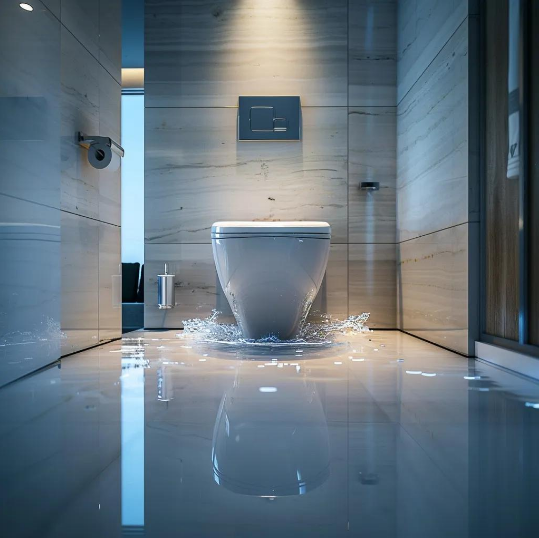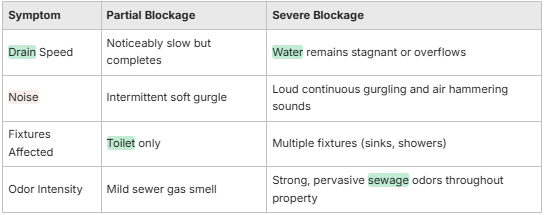
What are the Signs and Symptoms of a Blocked Toilet?
A blocked toilet can quickly escalate from a minor inconvenience to a full-scale plumbing emergency. At Mitchel Plumbing and Gas, we help homeowners spot blocked toilet signs early to avoid costly repairs and unsanitary conditions. This article maps out what a blocked toilet is and how it interrupts your plumbing system, highlights the key symptoms to watch for, guides you through simple self-diagnosis steps, explains when to call our expert team, answers common homeowner questions, and offers prevention tips to maintain healthy drains. Recognising these warning signals empowers you to act promptly and protect your home’s water flow and sanitary health.
What is a Blocked Toilet and How Does It Affect Your Plumbing System?
A blocked toilet occurs when an obstruction prevents the normal flow of waste and water through the bowl and drainpipe, causing pressure buildup that can force wastewater back into fixtures or damage pipe joints. Debris accumulation restricts the drain diameter, so each flush becomes less effective and water may remain stagnant. For example, a partial obstruction near the trap often causes slow flushing that can escalate into an overflow if left unaddressed. Recognising these mechanics sets the stage for understanding the most common blockage causes.
What Causes Toilet Blockages and Drain Obstructions?
Clogs arise when foreign objects, excess paper or congealed substances lodge in the trap or drain line, narrowing the passage and trapping waste. Over time, these materials compact and fully obstruct the pipe. For instance, flushing hygiene products or pouring cooking oils down the toilet can form hardened obstructions that resist simple plunging.
Below is an overview of primary blockage sources categorised by material type and real-life examples:

Each of these culprits demonstrates how everyday items can compromise your drainage. The buildup of fats, oils, and grease (FOG) is particularly problematic, as these substances can solidify within pipes and adhere to walls over time, significantly reducing flow capacity. With blockage sources clear, we can examine how those obstructions impact water flow and drainage.
How Does a Blocked Toilet Impact Water Flow and Drainage?
A blockage reduces the effective cross-section of the drainpipe, causing water to pool in the bowl and flow back into surrounding fixtures. This pressure imbalance creates air pockets that manifest as gurgling noises and erratic water levels. For example, a clogged trap may hold water in the bowl until pressure forces it over the rim. Understanding this effect underscores why early detection is so important.
Why Early Detection of Toilet Blockages is Important?
Detecting a developing clog at the first sign such as a change in flush speed, helps avoid more serious issues like structural pipe damage or full drain backups. A minor slowdown today can become an emergency overflow tomorrow, resulting in water damage and higher repair costs. Identifying early symptoms keeps your plumbing functioning smoothly and your maintenance budget under control.
What are the Key Signs Your Toilet is Blocked?

Blocked toilet signs often present as changes in sound, water behavior or odor. Recognising these signals quickly prevents escalation and preserves drain health for your entire household.
Why Does My Toilet Make a Gurgling Sound When Flushing?
A gurgling toilet sound indicates trapped air in your drain pipes caused by a partial blockage. As water pushes past the obstruction, pressure fluctuations force air pockets to escape, creating bubbling or gurgling noises. This warning sign often precedes more serious drainage restrictions.
How Can Slow Draining or Flushing Indicate a Partial Blockage?
When water drains unusually slowly after flushing, it reveals that restricted flow is impeding normal passage. Homeowners can observe this by timing the flush: a healthy toilet empties in under 10 seconds, while a partially blocked one takes noticeably longer. Slow drainage is an early alert to emerging obstructions.
What Do Changes in Toilet Water Level Reveal About Blockages?
Fluctuating water levels like either rising too high before receding or settling well below its normal mark, signal an imbalance in air and water flow caused by a clog. High water levels risk overflow, while low levels indicate severe restriction in the trap or vent line.
How Do Foul Odors Signal Sewer Gas or Waste Stagnation?
Unpleasant sewage smells around the toilet reveal that waste gases are trapped behind a blockage, allowing sewer gas to escape into your bathroom. Bacterial decomposition in stagnant water produces hydrogen sulfide and methane, which become noticeable odors when pipes cannot vent properly.
What Does Water Backing Up in Other Fixtures Mean?
If flushing the toilet causes water to appear in showers, sinks or bathtubs, it points to a main sewer line clog rather than an isolated trap blockage. Wastewater seeks the path of least resistance, exiting through adjacent fixtures when the primary line is obstructed.
When Are Persistent Clogs and Overflowing Toilets a Sign of Severe Blockage?
Ongoing clogs that return immediately after plunging or frequent overflows indicate a severe blockage deep in your drain stack. Immediate professional intervention is required to prevent structural pipe stress and extensive water damage.
How Can You Diagnose a Blocked Toilet Before Calling a Plumber?
A homeowner can perform targeted checks to differentiate minor obstructions from emergencies and determine if a professional drain clearing service is necessary.
What Simple Checks Can Identify Toilet Blockage Symptoms?
Before calling in experts, try these basic inspections:
- Listen for unusual gurgling during and after flushing.
- Observe water drainage speed and bowl refill times.
- Check the water level before and after a flush for abnormal changes.
- Test other fixtures to see if they back up when the toilet flushes.
- Use a standard plunger to gauge resistance and initial clearing success.
These steps clarify whether the issue is a simple trap clog or a complex sewer line obstruction.
How to Recognise Partial vs. Severe Toilet Blockages?
Partial and severe blockages differ in symptom intensity and affected areas. The table below compares key indicators:

When Should You Stop DIY and Seek Professional Help?

Stop DIY efforts and call Mitchel Plumbing and Gas if:
- The plunger fails to restore normal flush after two attempts.
- Multiple fixtures back up or emit sewer odors.
- Water continues to pool or overflow.
- You notice leaks around pipe joints or floor seals.
- DIY methods risk damaging porcelain or internal seals.
These criteria ensure safe, effective resolution and protect your plumbing investment.
When and Why Should You Call Mitchel Plumbing and Gas for Blocked Toilet Issues?
Expert intervention delivers reliable results with minimal disruption. Mitchel Plumbing and Gas combines advanced tools and 15 years of experience to clear drains safely and restore proper water flow.
What Emergency Plumbing Services Does Mitchel Plumbing and Gas Offer?
We provide:
- 24/7 blocked drain clearing with high-pressure hydro-jetting
- CCTV camera inspections for precise blockage location
- Root intrusion removal and sewer line repairs
- Rapid response for overflow and flood situations
How Does Expert Diagnosis Ensure Effective Blockage Resolution?
Our plumbers perform a structured diagnostic process:
- Visual inspection and pressure testing
- In-pipe camera survey to identify obstruction type and location
- Root cause analysis to prevent repeat blockages
- Tailored drain cleaning or pipe repair solution
Accurate diagnosis targets the underlying issue, ensuring lasting results.
What Makes Mitchel Plumbing and Gas the Trusted Choice for Toilet Repairs?
Customers choose our team for:
- Over 15 years of local plumbing expertise
- Licensed and insured technicians with ongoing training
- Customer satisfaction guarantee on all work
- Transparent pricing and clear communication
Our commitment to precision and reliability sets us apart for toilet and sewer solutions.
What Are Common Questions About Blocked Toilet Signs and Symptoms?
Why Does My Toilet Gurgle When I Flush?
A gurgling noise occurs when trapped air escapes around a partial clog, causing pressure fluctuations in the drainpipe and audible bubbling during water flow.
What Are the Signs of a Main Sewer Line Clog?
Water backing up in multiple fixtures, persistent foul odors throughout the home and slow drainage in sinks or tubs during flushing indicate a main sewer line obstruction.
Can a Partially Blocked Toilet Fix Itself?
No, a partial blockage rarely clears without intervention; debris compacts further with each flush, so professional cleaning is usually required to prevent full obstruction.
How Do I Know If My Toilet Is Partially Blocked?
Slow drainage, intermittent gurgling and higher-than-normal water levels in the bowl after flushing all point to a partial blockage in the trap or waste line.
What Happens If a Toilet Stays Clogged Too Long?
Ignoring a clog can lead to overflowing fixtures, pipe interior corrosion, mold growth, structural water damage and costly sewer line repairs.
How Can You Prevent Future Toilet Blockages and Maintain Healthy Drains?
What Maintenance Practices Reduce Blockage Risks?
Regularly use a flange plunger, flush enzyme-based drain cleaners monthly, remove visible debris from the bowl and inspect seals around the base for leaks to keep your drain system clear.
How Does Proper Usage Help Avoid Fatberg Formation and Clogs?
Avoid flushing wipes, paper towels, sanitary products and grease; these materials do not dissolve and can combine into fatbergs that firmly adhere to pipe walls.
When Should You Schedule Professional Drain Cleaning?
Arrange a professional drain cleaning at least once a year or whenever you notice early signs such as slow drains, gurgling sounds or minor odors to maintain optimal plumbing health and prevent emergencies.
Mitchel Plumbing and Gas stands ready to diagnose and resolve blocked toilet challenges with expertise and care. Contact our team for prompt service, clear communication and guaranteed satisfaction on all drain clearing and toilet repair needs.
Recent Post

7 Different Types of Gas Hot Water Systems
Gas hot water systems provide efficient heating solutions using natural gas or LPG. The seven main types include traditional storage tanks offering reliability with moderate efficiency; tankless systems delivering endless hot water without standby losses; advanced condensing models capturing exhaust heat; simpler non-condensing options; innovative hybrid systems combining multiple technologies; high-flow continuous systems for larger households; and compact instantaneous heaters for single-point use. Each type offers distinct advantages in efficiency, space requirements, and performance, with lifespans ranging from 10-20+ years depending on the technology and maintenance.

Gas vs Electric Hot Water Systems
At Mitchell Plumbing & Gas, we know that both gas and electric hot water systems offer different benefits for Brisbane homes. Gas hot water systems use natural gas or LPG to heat water, while electric hot water systems rely on electric heating elements. These hot water systems differ in several ways:

4 Best Gas Hot Water Systems
Gas hot water systems provide efficient heating for homes and businesses through storage tanks or continuous flow units. Top brands Rheem, Dux, Rinnai, and Bosch offer systems with varying flow rates suited to different household sizes. Benefits include faster heating than electric alternatives, lower running costs with natural gas, and functionality during power outages. When choosing, consider household size, space, gas supply, installation requirements, efficiency ratings and climate conditions.






.svg)